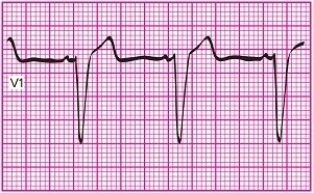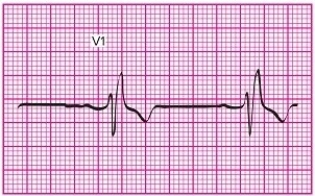Deck 10: Bundle Branch Block
Question
Question
Question
Question
Question
Question
Question
Question
Question
Question
Question
Question
Question
Question
Question
Question
Question
Question
Question
Question
Question
Question
Question

Unlock Deck
Sign up to unlock the cards in this deck!
Unlock Deck
Unlock Deck
1/23
Play
Full screen (f)
Deck 10: Bundle Branch Block
1
What happens when one or both of the ventricular pathways are not functioning properly due to damage or a delay from cardiac disease, drugs, or other conditions?
A)A bundle branch block occurs
B)The patient never experiences PVCs
C)An idioventricular rhythm occurs
D)A second degree AV heart block, type I occurs
A)A bundle branch block occurs
B)The patient never experiences PVCs
C)An idioventricular rhythm occurs
D)A second degree AV heart block, type I occurs
A bundle branch block occurs
2
A patient's dysrhythmia originates from above the ventricles and you notice QRS complexes on the ECG tracing measuring 0.12 second or greater. What could be the cause of this abnormal morphology?
A)Supraventricular tachycardia
B)Third-degree AV block
C)Bundle branch block
D)Atrial fibrillation
A)Supraventricular tachycardia
B)Third-degree AV block
C)Bundle branch block
D)Atrial fibrillation
Bundle branch block
3
Which of the following statements about bundle branch block is true?
A)Bundle branch block is a life-threatening condition.
B)Bundle branch block overrides the patient's underlying heart rhythm.
C)Any sinus, atrial, or junctional rhythm can be affected by bundle branch block.
D)If the patient has a bundle branch block, no P wave will be seen on the ECG tracing.
A)Bundle branch block is a life-threatening condition.
B)Bundle branch block overrides the patient's underlying heart rhythm.
C)Any sinus, atrial, or junctional rhythm can be affected by bundle branch block.
D)If the patient has a bundle branch block, no P wave will be seen on the ECG tracing.
Any sinus, atrial, or junctional rhythm can be affected by bundle branch block.
4
Which of the following is a characteristic of left bundle branch block?
A)The right ventricle depolarizes normally, but conduction through the left ventricle is slowed.
B)The left ventricle depolarizes normally, but the impulse is not spread to the right ventricle.
C)Neither ventricle depolarizes normally because the impulse is not conducted through the left bundle branch.
D)Neither ventricle depolarizes normally because the impulse is not conducted through the right bundle branch.
A)The right ventricle depolarizes normally, but conduction through the left ventricle is slowed.
B)The left ventricle depolarizes normally, but the impulse is not spread to the right ventricle.
C)Neither ventricle depolarizes normally because the impulse is not conducted through the left bundle branch.
D)Neither ventricle depolarizes normally because the impulse is not conducted through the right bundle branch.

Unlock Deck
Unlock for access to all 23 flashcards in this deck.
Unlock Deck
k this deck
5
Bundle branch block rhythm is similar to a sinus rhythm but has what distinguishing characteristic?
A)PR interval greater than 0.20 seconds
B)QRS duration less than 0.12 seconds
C)PR interval less than 0.12 seconds
D)QRS duration greater than 0.12 seconds
A)PR interval greater than 0.20 seconds
B)QRS duration less than 0.12 seconds
C)PR interval less than 0.12 seconds
D)QRS duration greater than 0.12 seconds

Unlock Deck
Unlock for access to all 23 flashcards in this deck.
Unlock Deck
k this deck
6
What rhythm is shown in this ECG tracing? 
A)Junctional escape rhythm
B)Sinus dysrhythmia with bundle branch block
C)Sinus bradycardia
D)Sinus bradycardia with bundle branch block

A)Junctional escape rhythm
B)Sinus dysrhythmia with bundle branch block
C)Sinus bradycardia
D)Sinus bradycardia with bundle branch block

Unlock Deck
Unlock for access to all 23 flashcards in this deck.
Unlock Deck
k this deck
7
What measurement on the ECG tracing represents how long it takes for the current to travel through the ventricular myocardial tissue?
A)PR interval
B)QRS duration
C)P-P interval
D)R-R interval
A)PR interval
B)QRS duration
C)P-P interval
D)R-R interval

Unlock Deck
Unlock for access to all 23 flashcards in this deck.
Unlock Deck
k this deck
8
When analyzing V1 to determine the presence of a bundle branch block, what should you look for?
A)A QRS complex that measures 0.12 seconds or greater and a P wave
B)A QRS complex that measures less than 0.12 seconds with no P wave
C)An inverted T wave and ST segment depression
D)ST segment elevation and a pathologic Q wave
A)A QRS complex that measures 0.12 seconds or greater and a P wave
B)A QRS complex that measures less than 0.12 seconds with no P wave
C)An inverted T wave and ST segment depression
D)ST segment elevation and a pathologic Q wave

Unlock Deck
Unlock for access to all 23 flashcards in this deck.
Unlock Deck
k this deck
9
In a left bundle branch block (LBBB), how does the QRS appear?
A)Normal in length
B)Positively deflected
C)Negatively deflected
D)Taller and deeper than normal
A)Normal in length
B)Positively deflected
C)Negatively deflected
D)Taller and deeper than normal

Unlock Deck
Unlock for access to all 23 flashcards in this deck.
Unlock Deck
k this deck
10
Which lead is referenced to distinguish a right bundle branch block (RBBB)from a left bundle branch block (LBBB)?
A)Lead I
B)aVF
C)V6
D)V1
A)Lead I
B)aVF
C)V6
D)V1

Unlock Deck
Unlock for access to all 23 flashcards in this deck.
Unlock Deck
k this deck
11
Where can right and left bundle branch blocks be differentiated?
A)In the precordial leads
B)In the limb leads
C)In the bipolar leads
D)In the augmented leads
A)In the precordial leads
B)In the limb leads
C)In the bipolar leads
D)In the augmented leads

Unlock Deck
Unlock for access to all 23 flashcards in this deck.
Unlock Deck
k this deck
12
A bundle branch block has which of the following characteristics?
A)It causes narrowed QRS complexes to appear on the ECG.
B)It accelerates depolarization of the ventricle it supplies.
C)It occurs when the bundle branches fail to conduct impulses.
D)It causes a prolonged PR interval.
A)It causes narrowed QRS complexes to appear on the ECG.
B)It accelerates depolarization of the ventricle it supplies.
C)It occurs when the bundle branches fail to conduct impulses.
D)It causes a prolonged PR interval.

Unlock Deck
Unlock for access to all 23 flashcards in this deck.
Unlock Deck
k this deck
13
You observe a wide QRS complex in lead II. Which lead should you check to evaluate the location of the bundle branch block?
A)Lead I
B)Lead V1
C)Lead III
D)Lead V4
A)Lead I
B)Lead V1
C)Lead III
D)Lead V4

Unlock Deck
Unlock for access to all 23 flashcards in this deck.
Unlock Deck
k this deck
14
In a right bundle branch block (RBBB), how does the QRS appear?
A)Normal in length
B)Positively deflected
C)Negatively deflected
D)Taller and deeper than normal
A)Normal in length
B)Positively deflected
C)Negatively deflected
D)Taller and deeper than normal

Unlock Deck
Unlock for access to all 23 flashcards in this deck.
Unlock Deck
k this deck
15
What is the condition in which impulses generated in the atria are delayed because of damage in the ventricular electrical pathways?
A)First-degree AV block
B)Bradycardia
C)Idioventricular rhythm
D)Bundle branch block
A)First-degree AV block
B)Bradycardia
C)Idioventricular rhythm
D)Bundle branch block

Unlock Deck
Unlock for access to all 23 flashcards in this deck.
Unlock Deck
k this deck
16
You are about to perform an ECG on a patient known to have sinus tachycardia with right bundle branch block. Which of the following signs and symptoms would you be likely to find in this patient?
A)Hypertension
B)Congestive heart failure
C)Unconsciousness
D)Rapid heart rate
A)Hypertension
B)Congestive heart failure
C)Unconsciousness
D)Rapid heart rate

Unlock Deck
Unlock for access to all 23 flashcards in this deck.
Unlock Deck
k this deck
17
A bundle branch block must be considered when the QRS complex measures what length?
A)0)12 seconds or greater
B)0)06 to 0.10 seconds
C)Less than 0.06 seconds
D)0)04 to 0.08 seconds
A)0)12 seconds or greater
B)0)06 to 0.10 seconds
C)Less than 0.06 seconds
D)0)04 to 0.08 seconds

Unlock Deck
Unlock for access to all 23 flashcards in this deck.
Unlock Deck
k this deck
18
The V1 tracing shown here is from a 12-lead ECG performed on a 36-year-old male patient as part of a yearly physical examination. The patient appears to be in good general health. What does this tracing show? 
A)Left bundle branch block
B)Right bundle branch block
C)Complete AV block
D)Left ventricular hypertrophy

A)Left bundle branch block
B)Right bundle branch block
C)Complete AV block
D)Left ventricular hypertrophy

Unlock Deck
Unlock for access to all 23 flashcards in this deck.
Unlock Deck
k this deck
19
What additional patient information is needed on the ECG tracing when a bundle branch block is discovered?
A)Patient's cardiac history
B)Patient's symptoms
C)Patient's blood pressure reading
D)Patient's underlying rhythm
A)Patient's cardiac history
B)Patient's symptoms
C)Patient's blood pressure reading
D)Patient's underlying rhythm

Unlock Deck
Unlock for access to all 23 flashcards in this deck.
Unlock Deck
k this deck
20
How is a right bundle branch block (RBBB)distinguished from a left bundle branch block (LBBB)?
A)Monitor lead V1. If the majority of the ventricular depolarization is positively deflected, it is RBBB; if the QRS is negative, it is LBBB
B)Monitor lead V1. If the majority of the ventricular depolarization is positively deflected, it is LBBB; if the QRS is negative, it is RBBB
C)Monitor leads V1 to V6 and measure the PR interval
D)Monitor leads I, II, and III and observe the P wave configuration
A)Monitor lead V1. If the majority of the ventricular depolarization is positively deflected, it is RBBB; if the QRS is negative, it is LBBB
B)Monitor lead V1. If the majority of the ventricular depolarization is positively deflected, it is LBBB; if the QRS is negative, it is RBBB
C)Monitor leads V1 to V6 and measure the PR interval
D)Monitor leads I, II, and III and observe the P wave configuration

Unlock Deck
Unlock for access to all 23 flashcards in this deck.
Unlock Deck
k this deck
21
What is a QS complex?
A)A QRS complex in which the R wave is buried in the Q wave
B)A deep Q/S wave with no preceding R wave
C)A QRS complex with no preceding P wave
D)An inverted QRS complex
A)A QRS complex in which the R wave is buried in the Q wave
B)A deep Q/S wave with no preceding R wave
C)A QRS complex with no preceding P wave
D)An inverted QRS complex

Unlock Deck
Unlock for access to all 23 flashcards in this deck.
Unlock Deck
k this deck
22
You have run a 12-lead ECG on Ms. Reilly, a patient in the cardiac care unit of the hospital where you work. A portion of the V1 tracing is shown here. What cardiac condition would you suspect based on this tracing? 
A)Left bundle branch block
B)Right bundle branch block
C)Complete AV block
D)Left ventricular hypertrophy

A)Left bundle branch block
B)Right bundle branch block
C)Complete AV block
D)Left ventricular hypertrophy

Unlock Deck
Unlock for access to all 23 flashcards in this deck.
Unlock Deck
k this deck
23
You have run a 12-lead ECG on Mrs. Simmons. In lead V1, you notice that the QRS is positive and has a "bunny ears" appearance. What does Mrs. Simmons most likely have?
A)Left bundle branch block
B)Right bundle branch block
C)Complete AV block
D)Left ventricular hypertrophy
A)Left bundle branch block
B)Right bundle branch block
C)Complete AV block
D)Left ventricular hypertrophy

Unlock Deck
Unlock for access to all 23 flashcards in this deck.
Unlock Deck
k this deck



